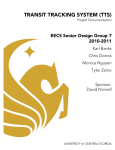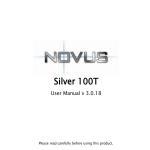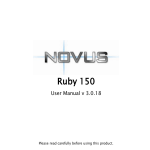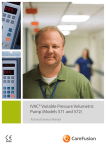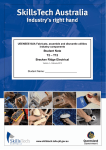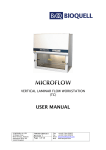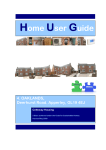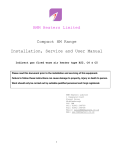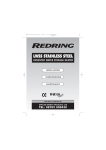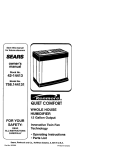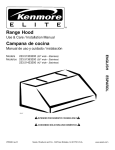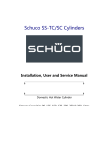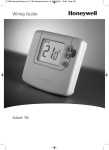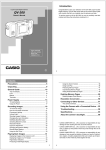Download Installations, User and Service Manual Section A
Transcript
Version 6.1 14/07/2014 Installations, User and Service Manual Section A Domestic Hot Water Cylinder 3C382B | 3C510B | 3C382HP | 3C510HP Section B Solar 3C Heating System Important -This manual should be left with the cylinder after installation Solar 3C 01242 253817 [email protected] Solar 3C Unit 1 20 Winchcombe Street Cheltenham GL52 2LY Installations, User and Service Manual Section A Domestic Hot Water Cylinder 3C382B | 3C510B | 3C382HP | 3C510HP Important - This manual should be left with the cylinder after installation 2 Solar 3C Cylinder Range Installation and Service Manual Index Section 1 2 3 4 5 6 7 8 9 10 11 12 13 14 15 Introduction Technical specifications Check list General requirements Primary circuit installation Secondary circuit installation Discharge arrangement Electrical installation Filling and commissioning Servicing and maintenance Spare parts list Fault finding User instructions Warranty Installation, commissioning and service record 1. Introduction The Solar 3C Cylinder is a high quality stainless steel hot water cylinder suitable for use on unvented or open vented hot water systems. The indirect heat exchange surfaces are designed to provide rapid heat up. The indirect units incorporate 2 x 3kW electric immersion heaters as backup. When the unit is supplied for unvented applications, it comes complete with all the necessary safety equipment to comply with legislation governing the installation of such systems. The temperature and pressure relief valve is factory fitted. The Solar 3C Cylinder range has 3-coils; the bottom coil is for the solar thermal connection, the middle coil for conventional boiler or heat pump back up (both middle & bottom are input coils) and a top coil which is designed as an output coil. This coil, sat in a reservoir of energy hopefully supplied via the solar thermal collectors, will enable the energy to be taken from the cylinder indirectly to the heating load via the Solar 3C purpose control box and jig. All the installation, user and service instructions given for the Solar 3C Cylinder range apply to the 3C382B, 3C510B, 3C382HP and 3C510HP cylinders unless otherwise stated. 3 2. Technical specifications Solar 3C 3- Coil Indirect Cylinders 3C382B 3C510B 3C382HP 3C510HP Storage capacity (litres) 382 510 382 510 Overall diameter (mm) 580 663 580 663 Overall diameter incl. immersion heater mm 642 725 642 725 Overall height with exp. vessel on cold feed supply (mm) 2100 2057 2100 2057 Primary flow/return connections (mm) 22 22 22 22 Secondary return (mm) 15 15 15 15 Cold feed/ hot draw off connections (mm) 28 28 28 28 Maximum water supply pressure (bar) 10 10 10 10 Weight when full (kg) System operating pressure (pre-set) (bar) 3 3 3 3 Expansion vessel charge pressure (bar) 2 2 2 2 Expansion relief valve set pressure (bar) 6 6 6 6 7 7 7 7 90+/-5 90+/-5 90+/-5 90+/-5 3 3 3 3 Hot water generation time from 15 to 65 (ºC) for ‘indirect’ cylinder (min) 51mins 63mins 51mins 63mins Regeneration time for 70% of contents for ‘indirect’ cylinder (min) 39mins 53mins 39mins 53mins 3.42 4.14 3.42 4.14 Temperature and pressure relief value set: Lift pressure (bar) Lift temperature (ºC) Maximum primary working pressure (bar) Performance Heat Loss (kW/h per day) 3. Check list 3- Coil Indirect Cylinders 3C382B 3C510B 3C382HP 3C510HP Cylinder assembly 382 litre 1 - - - Cylinder assembly 510 litre - 1 - - Cylinder assembly 382 litre - - 1 - Cylinder assembly HP 510 litre - - - 1 Expansion vessel 35 Litre 1 - 1 - Expansion vessel 80 Litre - 1 - 1 Pressure reducing valve 1 1 1 1 Expansion relfief valve 1 1 1 1 T/P valve, pre fitted 1 1 1 1 15/22 Tundish 1 1 1 1 22mm DHW motorised valve 1 1 1 1 22mm High temp motorised valve 1 1 1 1 Control/ limit thermostat 2 2 2 2 Immersion heater pre fitted 2 2 2 2 Note: The expansion vessel should be fitted on the cold water supply. 4 4. General requirements 4.1. The Solar 3C domestic hot water cylinder MUST be installed by a competent person in accordance with WRAS and section G3 of the current Building Regulations. 4.2. Important - It is important that the installer reads and understands these instructions, unpacks and familiarises themselves with the equipment before commencing the installation. Failure to observe these installation instructions could invalidate the warranty. 4.3. Water supply - The warranty requires that the water to be heated is wholesome and of drinking water quality and that if water treatment equipment is installed, it must function correctly. Where possible the unit should be fed via at least Ø22mm (mains water) supply pipe. It requires a supply pressure of 1.0 bar with a flow rate of at least 10 Litres per minute as a minimum for it to function. Even with these rates, flow from the outlets will be disappointing/poor if several outlets are used simultaneously. Generally speaking, the higher the supply pressure, the better the system will function. The cylinder control equipment is factory set to limit the system operating pressure to 3 bar. The maximum supply pressure in to the pressure-reducing valve is 10 bar. 4.4. Taps and fittings - All taps and fittings incorporated in the unvented system should have a rated operating pressure of 7 bar or above. 4.5. Location – The unit is designed to be floor standing, vertically mounted, indoors, in a frost-free environment. When choosing a suitable location for the cylinder, consideration should be given to the routing of the discharge pipe to a convenient point and also the availability of an adequate power supply for connecting the immersion heater(s). The cylinder may stand on any flat and level surface without any special foundation preparations, provided that it is sufficiently robust to support the full weight of the cylinder. (Refer to technical specifications for weights). The position of the cylinder should be such that easy access is provided for servicing the controls and replacing the immersion heater should the need arise. Generally, pipe runs should be made as short as possible and lagged to prevent heat loss. All pipework connections are to meet and be installed to any/all relevant standards at the time of installation. 4.6. Storage and handling – If the cylinder is not being installed immediately, it should remain in its packaging with all pipe end protective caps in situ to prevent damage. We recommend that the cylinder be transported to its installation position on a sack truck or similar with the outer packaging in place. 5 Fig.1a. Solar 3C Cylinder Three Coil pipe work connections - 382B and 510B cylinders HOT OUT 3 'SOLAR3C' OUTPUT COIL ONLY 7 7 8 9 11 10 12 2 SOLAR3C PROBE SECONDARY RETURN 4 6 5 BOILER INPUT COIL CYLINDER STAT 1 SOLAR INPUT COIL 5 SOLAR HIGH-LIMIT STAT 4 SOLAR SYSTEM PROBE 7 COLD IN Item Description Quantity Item Description Quantity 1 Triple Coil Cylinder 1 9 Tundish 1 2 Expansion Vessel 1 10 28mm monobloc inlet kit 1 3 3/4” T&P Relief Valve 1 11 10 bar Pressure Gauge 1 4 1 3/4” Immersion heater 2 12 22mm 2 Port Solar Zone Valve 1 5 Cylinder Thermostat 1 6 Auxillary sensor pocket 0 7 Probe Pocket only 2 8 22mm 2 Port zone valve 1 For illustration purposes only. 6 Fig.1b. Solar 3C Cylinder Three Coil pipe work connections - 382HP and 510HP cylinders HOT OUT 3 'SOLAR3C' OUTPUT COIL ONLY 7 7 8 SOLAR3C PROBE 11 10 SECONDARY RETURN 4 HEAT PUMP INPUT COIL 6 5 9 10 11 12 2 CYLINDER STAT 1 SOLAR INPUT COIL 4 *3C382HP ONLY 5 SOLAR HIGH-LIMIT STAT 4 SOLAR SYSTEM PROBE Item COLD IN 7 Description Quantity Item Description Quantity 1 Triple Coil Cylinder 1 9 Tundish 1 2 Expansion Vessel 1 10 28mm monobloc inlet kit 1 3 3/4” T&P Relief Valve 1 11 10 bar Pressure Gauge 1 12 22mm 2 Port Solar Zone Valve 1 4 1 3/4” Immersion heater 2* 5 Cylinder Thermostat 1 6 Auxillary sensor pocket 0 7 Probe Pocket only 2 8 22mm 2 Port zone valve 1 * Middle immersion heater is only on 3C382HP cylinder For illustration purposes only. 7 5. Primary circuit installation 5.1. Solar 3C cylinders are suitable for connecting to most fully pumped domestic central heating (an open vented or sealed system), having a maximum working pressure of 3 bar and a maximum working temperature of 90 degrees centigrade. If you are in any doubt concerning the suitability of the boiler, consult the boiler manufacturer. Solid fuel or wood burning boilers, and gravity circulation systems MUST NOT be used on the primary circuit of an unvented hot water system. 5.2. Systems - For the best results we recommend that the Solar 3C Cylinder be connected to a “S” plan type system. Solar 3C Cylinder can be used on “S” plan or “Y” plan systems only. This cylinder incorporates a solar coil, situated below the boiler primary coil. The boiler/primary coil connections should be made in accordance with the instructions given at the beginning of this section. ENSURE THAT YOU CONNECT THE PRIMARY ENERGY SOURCE, NORMALLY A GAS/OIL BOILER OR AIR SOURCE HEAT PUMP TO THE MIDDLE BOILER/HEAT PUMP COIL ONLY. THE TOP COIL MARKED ‘OUTPUT COIL ONLY’ IS ONLY TO BE USED AS AN OUTPUT COIL (SEE FIGURES 1A AND B) AND NOT TO BE USED AS AN INPUT COIL. 5.3. The following wiring diagrams are for guidance only. The system must be wired in accordance with the boiler manufactures instructions and any regulations with regard to unvented cylinders. Solar 3C accepts no liability for connection to the cylinder. The lower/bottom solar coil is used for energy input from a secondary source (examples include solar collectors) having a maximum working pressure of 3 bar and a maximum working temperature of 90 degrees centigrade. The lower coil has its own temperature sensing point – this is a stainless steel pocket. In addition there is a further sensing pocket should overall control of the cylinder temperature be required. Thermostats for these sensing points are not supplied. The flow from the secondary energy source should be connected to the top connection on the bottom/solar coil and the return to the bottom. The motorised valves (including high temperature motorised valve) must be connected to the high limit on the cylinder thermostat in such a way as to isolate the cylinder from the primary and secondary energy sources if the cylinder temperature exceeds the high set point. Please see the section on electrical installation. THIS IS ESSENTIAL TO ENSURE A SAFE WORKING PRODUCT & TO AVOID EXCESSIVELY HOT WATER. CORRECT WIRING OF THE THERMAL CUTOUT MUST BE UNDERTAKEN. 5.4. Connections - The primary flow and return connections should be made in accordance with Figs 1a and 1b. using 22mm compression fittings, (not supplied). Note, connections for the boiler are shown with the return above the flow; however, you can also connect the flow above the return. 5.5. The 2 port valve - To prevent gravity circulation when the boiler switches off, the 2 port motorised valve supplied with the unvented hot water kit, MUST be fitted in the primary flow pipe to the cylinder and wired in accordance with Figs 2, 3 and 4 (depending on system design) to comply with current legislation. 5.6. Hard water areas - If the cylinder is to be used in a hard water area, we recommend that the primary flow temperature be limited to 75 degrees centigrade. This will help reduce the migration of suspended solids in the water and help prevent the buildup of lime scale. 5.7. ON ALL SYSTEM CONFIGURATIONS: Secondary circulation – Solar 3C cylinders provide a secondary return connection for a secondary circulation circuit, 15mm leg incorporating a check valve (see Figs 1a and 1b for position of secondary return). IMPORTANT: If a secondary circulation circuit is installed then a larger expansion vessel may be required to handle the increase in volume. Please ensure all installation and design considerations are met and double 8 checked prior to hand over to the end user. 230V 50Hz 3A RATED MID POSITION ZONE VALVE CYLINDER STAT. 1 L NE V4043 ROOM STAT. BROWN N 1 3 1 2 3 4 C 5 6 BLUE WHITE 1. It is recommended that the 10 way junction box should be used to ensure first time, fault free wiring. ORANGE BLUE NOTE: GREY Fig.2. “Y” Plan wiring layout and system schematic G/YELLOW 2 PORT ZONE VALVE 2 7 8 9 NOTE: ORANGE AND GREY WIRES NOT REQUIRED ELECTRICALLY ISOLATE 10 C 7 LINK 8 TO 10 8 9 10 ST9400A/C HW OFF HW ON HTG Pump overrun L E N N L NE L PUMP BOILER SL PL L E N NEL PUMP BOILER Solar 3C Jig Space Heating Solar 3C Cylinder Cylinder Stat. Boiler Radiators 2 Port Zone Valve 3 Port Mid-Postion Valve For illustration purposes only. 9 MID POSITION ZONE VALVE CYLINDER STAT. 1 L NE V4043 ROOM STAT. BROWN N 1 3 1 2 3 4 C 5 6 BLUE ORANGE 230V 50Hz 3A RATED WHITE 1. It is recommended that the 10 way junction box should be used to ensure first time, fault free wiring. BLUE NOTE: GREY Fig.3. “S” Plan wiring layout and system schematic G/YELLOW 2 PORT ZONE VALVE 2 7 8 9 NOTE: ORANGE AND GREY WIRES NOT REQUIRED ELECTRICALLY ISOLATE 10 C 7 LINK 8 TO 10 8 9 10 ST9400A/C HW OFF HW ON HTG Pump overrun L E N N L NE L PUMP BOILER SL PL L E N NEL PUMP BOILER Solar 3C Jig Space Heating Solar 3C Cylinder Cylinder Stat. Boiler 2 Port Zone Valve Radiators 2 Port Zone Valve For illustration purposes only. 10 Fig. 4a. “S” Plan wiring layout and system schematic for Solar 3C Heating System 2 PORT ZONE VALVE HTG CYLINDER STAT. ROOM STAT. N 1 3 G/Y L NE GREY 1 BROWN BLUE MOTOR ORANGE BLUE 230V 50Hz 3A RATED MOTOR BROWN G/YELLOW 2. If using the V4043H1080 (1” BSP) or V4043H1106 (28mm), the white wire must be electrically isolated. GREY 1. We recommend a 10 way junction box or Sundial Wiring Centre is used. V4043H ZONE VALVE HW ORANGE NOTE: C Solar 3C Control Panel Pump overrun 7 8 9 1 10 N L NE L PUMP SL PL L E N BOILER 2 3 4 5 N 6 7 8 9 10 NE L PUMP HWHTG L E N BOILER See Section B for full wiring instructions for the Solar 3C Control Panel Solar 3C Jig Space Heating Solar 3C Cylinder Boiler Radiators For illustration purposes only. 11 Fig. 4b. System schematic for Solar 3C Heating System with Towel Rail 2 PORT ZONE VALVE HTG CYLINDER STAT. ROOM STAT. N 1 3 G/Y L NE GREY 1 BROWN BLUE MOTOR ORANGE BLUE 230V 50Hz 3A RATED MOTOR BROWN G/YELLOW 2. If using the V4043H1080 (1” BSP) or V4043H1106 (28mm), the white wire must be electrically isolated. GREY 1. We recommend a 10 way junction box or Sundial Wiring Centre is used. V4043H ZONE VALVE HW ORANGE NOTE: Solar 3C Control Panel 8 9 BLUE Pump overrun 7 1 10 PUMP 2 3 4 5 6 7 8 9 10 BROWN MOTOR G/Y N L NE L C SL PL L E N BOILER N NE L PUMP HWHTG L E N 3 PORT DIVERTER VALVE BOILER See Section B for full wiring instructions for the Solar 3C Control Panel Towel Rail Solar 3C Jig Space Heating Solar 3C Cylinder Boiler Check valve Diverter valve Radiators For illustration purposes only. 12 Fig. 5. Wiring layout and system schematic for solar collectors using the high temp zone valve 2 PORT HI-TEMP VALVE 230V 50Hz 3A RATED BLUE G/YELLOW SOLAR CYLINDER STAT. L N E MOTOR BROWN 1 C L N E SL SOLAR CONTROLLER N EL E N L SOLAR PUMP STATION For illustration purposes only. 13 6. Secondary circuit installation 6.1. Connections – Secondary circuit connections MUST be made to the cylinder in accordance with Figs 1a and 1b. A drain cock (not supplied) should be fitted in the position shown in Figs 1a and 1b to facilitate draining of the cylinder. 6.2. Cold water supply – Where possible, for best results, the cylinder should be fed by an uninterrupted 22mm supply pipe into the pressure reducing valve (PRV) with a supply pressure of between 3 and 12 bar maximum. In the UK, supply pressures this high are not always available. However the system will still work satisfactorily with pressures below this. The cylinder should not be used on any system with a supply pressure below 1 bar and a flow rate of less than 10 Litres per minute. 6.3. Temperature and pressure relief valve – The temperature and pressure relief valve (TPV) is supplied factory fitted to the cylinder. The TPV must not be removed from the cylinder or tampered with in any way. The valve is pre calibrated to lift at 7 bar or 90 degrees centigrade and any attempt to adjust it will invalidate the warranty. 6.4. Expansion vessel – A suitable expansion vessel with a pre-charge pressure of 3 bar is supplied for fitting to all cylinders. All Solar 3C Cylinders must be fitted with a potable water expansion vessel (supplied) and the expansion vessel MUST be connected into the cold water supply after the pressure reducing valve. If the expansion vessel is connected into the cold water supply, it MUST be fitted between the expansion relief valve and the cylinder. The expansion vessel MUST be positioned with the entry point at the bottom. IMPORTANT: Regular checks must be carried out to ensure that the expansion vessel is correctly pressurised to 1.5 bar at all times. 6.5. Pressure reducing valve – Taking due account of the directional arrow, fit the pressure reducing valve (PRV) in accordance with Figs 1a and 1b. This can be connected to a supply pressure of between 1 and 10 bar maximum. The included pressure gauge to check flow pressure is to be removed after the pressure is set. 6.6. Expansion relief valve – Fit the expansion relief valve (ERV) in accordance with Figs 1a and 1b. This valve has been pre-set to lift at 6 bar. No other valve should be fitted between the expansion relief valve and the cylinder. 6.7. Check valve (28mm monoblock inlet kit) – Taking due account of the directional arrow, fit the check valve (CV) in accordance with Figs 1a and 1b. The monoblock can be used for balance cold outlet. 6.8. Secondary circulation – The Solar 3C Cylinder provides a secondary return connection to which a secondary circulation circuit, 15mm leg incorporating a check valve, could be connected (see Figs 1a and 1b for position of secondary return). IMPORTANT: If a secondary circulation circuit is installed then a larger expansion vessel may be required to handle the increase in volume within secondary up to capacity of expansion vessel. Please ensure all installation and design considerations are met and double checked prior to hand over to the end user. 6.9. Tundish – The tundish must not be positioned above or in close proximity of any electrical current carrying devices or wiring. 14 7. Discharge Arrangement The user must install a Tundish in a position so that it is clearly visible and positioned away from electrical devices. In addition, the discharge pipe from the Tundish should terminate in a safe place where there is no risk to persons in the vicinity of the discharge, be of metal and: (a) Must be at least one pipe size larger than the normal outlet size of the safety device unless its total equipment hydraulic resistance exceeds that of a straight pipe 9m long, i.e. discharge pipes between 9m and 18m. Equivalent resistance length should be at least two sizes larger than the normal outlet size of the safety device, between 18m and 27m at least three sizes larger and so on. Bends must be taken into account in calculating the flow resistance. Refer to the diagram, tables and worked example detailed in Fig 7. (b) Have a vertical section of pipe at least 600 mm long below the Tundish before any elbows or bends in the pipe work. (c) Be installed with a continuous fall. (d) Have discharges visible at both Tundish and the final point of discharge, but where this is not possible or practically difficult, examples of acceptable discharge arrangements are; • • • • Ideally below a fixed grating and above the water seal in a trapped gully. Downward discharge at low level, i.e. up to 100 mm above external surfaces such as car parks, hard standings, grassed areas, etc. are acceptable providing that where children play or otherwise come into contact with discharges, a wire cage or similar guard is positioned to prevent contact whilst maintaining visibility. Discharge at high level, e.g. into a metal hopper and metal down pipe with the end of the discharge pipe clearly visible (Tundish visible or not) or onto a roof capable of withstanding high temperature discharges of water and 3m from any plastic guttering system that would collect such discharges (Tundish visible). Where a single pipe serves a number of discharges such as in blocks of flats, the number served should be limited to not more than six systems so that any installation discharging can be traced reasonably easily. The single common discharge pipe should be at least one pipe size larger than the largest individual discharge pipe to be connected. If unvented hot water stored systems are installed where discharges from safety devices may not be apparent i.e. in dwellings occupied by blind, or disabled people, consideration should be given to the installation of an electrically operated device to warn when discharge takes place. WARNING: THE DISCHARGE WILL CONSIST OF SCALDING WATER AND STEAM. ASPHALT, ROOFING FELT AND NON-METALLIC RAINWATER GOODS MAY BE DAMAGED BY SUCH DISCHARGES. Fig 7. Table, worked example and diagram for discharge arrangement. Valve outlet Min size of dissize, dicharge pipe D1 in ameter in ‘mm’ ‘inches’ 15 Max resistance allowed, expressed as a length of straight pipe, i.e. no elbows or bends Resistance created by each elbow or bend in ‘m’ 1/2 Min size of discharge pipe D2 from tundish in ‘mm’ 3/4 22 1 28 28 35 42 Up to 9 Up to 18 Up to 27 ------1.7 22 28 35 35 42 54 Up to 9 Up to 18 Up to 27 0.8 1.0 1.4 Up to 9 Up to 18 Up to 27 1.4 1.7 2.3 Sizing of copper discharge pipe “D2” for common temperature relief valve outlet sizes 15 Worked example The example below is for a ½”diameter temperature relief valve with a discharge pipe (D2) having 4 No elbows and a length of 7m from the tundish to the point of discharge. Maximum resistance allowed for a straight length of Ø22mm copper discharge pipe (D2) from a ½” diameter temperature relief valve is - 9.0 m. Subtract the resistance for quantity of 4 Ø22mm elbows at 0.8 m each = 3.2m. Therefore, the maximum permitted length equates to 5.8m. 5.8m is less than the actual length of 7m, therefore, calculates the next largest size. Maximum resistance allowed for a straight length of Ø28mm-pipe (D2) from a ½” diameter temperature relief valve equates to - 18m. Subtract the resistance for a quantity of 4 Ø28mm elbows at 1.0 each = 4m. Therefore the maximum permitted length equates to 14m. As the actual length is 7m, an Ø28mm diameter copper pipe will be satisfactory 600 min A typical discharge pipe arrangement For illustration purposes only. 16 8. Electrical installation WARNING - THIS EQUIPMENT MUST BE EARTHED. 8.1. All electrical wiring must be carried out by a competent person and in accordance with the current I.E.E. Wiring Regulations. A suitable Earthing point is provided on the cylinder pedestal directly below the immersion heater (see Fig 8). 8.2. The control equipment supplied will ensure that the cylinder functions safely. All control equipment must be supplied via a 3Amp supply and a double pole switch with a minimum 3mm gap. From an economic and convenience point of view, it is intended that these controls operate in conjunction with other control packages for example: Solar 3C Solar Heating System or “S” and “Y” plan systems which incorporate a programmable time clock etc. 8.3. The immersion heaters – 2 x 3kW 230v 50Hz-immersion heaters should be wired in accordance with the instructions given in Fig 8. The cable MUST be routed through the strain relief bush. We recommend that the control thermostat is set at 60°C; the high limit trip is factory set at 85°C. The immersion heater conforms to EEC Directive 76/889 for radio interference and complies with BS 800:1977. WARNING: NEVER FIT AN IMMERSION HEATER WITHOUT A THERMAL CUT OUT. 8.4. The indirect temperature controller - The control and high limit thermostat for use with indirect systems is supplied separately with the unvented hot water safety kit. It should be fitted into the sensor pocket in the cylinder (see Fig 1 for position). The control thermostat has an adjustment range between 30°C and 90°C, however it is recommended this it be set to 60°C WARNING: THE MANUAL RE-SET HIGH LIMIT THERMOSTAT MUST NOT UNDER ANY CIRCUMSTANCES BE BYPASSED. THIS IS PRE-SET TO 80°C AND TO PREVENT NUISANCE TRIPPING THE CONTROL THERMOSTAT SHOULD ALWAYS BE AT LEAST 15°C BELOW THIS. 8.5. The 2 port valve - To prevent gravity circulation when the boiler switches off, the 2 port motorised valve supplied with the unvented hot water kit MUST be fitted in the primary flow pipe to the cylinder and wired in accordance with Figs 2, 3, 4 (depending on system design), to comply with current legislation. Installation and Servicing Manual Immersion heater installation and wiring instructions 1. Ensure the main’s voltage corresponds to the voltage rating of the immersion heater as shown on the rating label on the terminal cover. 2. Install the immersion heater into the domestic hot water cylinder using the gasket provided. Use a shaped spanner-Stillsons or pipe grips should not be used. The use of sealing compound is not recommended. 3. Wire the immersion heater in accordance with Fig 8. It should be wired through a double pole isolator switch or controller, having contact separation of at least 3 mm, using 1.5mm sq. flexible cable, 85°C rubber insulated HOFR sheathed, to comply with BS 6141 table 8 and must be fully earthed. 4. The BEAB approval certification on this immersion heater only applies if rod type thermostats, types Sunvic VKL or Cotherm SHD are used. The temperature setting of the control thermostat must not exceed 60°C. 5. In the event of the manual reset cut-out operating, isolate the immersion heater from the mains supply, investigate and identify the cause of the operation of this cut-out, rectify the fault before manually resetting the cut-out via the reset button on the cut-out. Finally switch the mains electricity supply back on. 17 Fig 8. Immersion Heater Wiring WARNING: THIS APPLIANCE MUST BE EARTHED 9. Filling and commissioning 9.1. Check that the expansion vessel charge pressure is 3 bar. 9.2. Check that all connections are made tight including the immersion heater. 9.3. Open the main stopcock and fill the secondary system first. Open successive taps (hot and cold) starting with the tap furthest from the cylinder. Leave each tap open for a few moments to allow all air and possibly debris from the system to exit. Manually lift (by rotating the knob) both the expansion relief (EV) and the temperature and pressure relief valve (TPV) for a short period to remove trapped air from behind the valve seating and to prove the correct function of the discharge arrangement. 9.4. Check all joints for leaks and rectify as necessary. 9.5. Check that the control and high limit settings for the indirect system and the immersion heater are as required. 9.6. Fill the primary side, (note: it will be necessary to manually open the 2 port valve whilst filling the system, this is achieved by moving the lever on the valve head sideways). Check for leaks and rectify as necessary. Vent all heat emitters of air and following the manufacturers lighting instructions ignite the boiler. 9.7. Check that while the cylinder is heating up, no water leaks from either the expansion relief or the temperature and pressure relief valve and when the cylinder reaches temperature, that the 2 port 18 valve closes. 10. Servicing and maintenance 10.1. A competent unvented hot water installer must only carry out servicing and maintenance. 10.2. Before any work whatsoever is carried out on the installation, it MUST first be isolated from the main’s electricity supply. WARNING: BOTH THE PRIMARY AND SECONDARY SYSTEMS WILL CONTAIN VERY HOT WATER THAT WILL SCALD, THEREFORE CARE SHOULD BE TAKEN WHEN OPENING ANY JOINTS, SEALS OR VALVES. 10.3. Only use spare parts authorised by Solar 3C. The use of unscheduled spare parts will invalidate the warranty. 10.4. Drain the cylinder – When draining the cylinder, always switch off the boiler and the immersion heater first. Turn off the water supply at the stopcock (Figs 1a and 1b). Connect a hose pipe to the drain cock (Figs 1a and 1b) and route it to a convenient gully. Open the drain cock and all hot taps that are served by the cylinder. The cylinder may take several minutes to empty completely. 10.5. In hard water areas it may be necessary from time to time to remove and de-scale the immersion heater element. Replace the gasket each time it is removed. 10.6. Remove the cartridge from the pressure-reducing valve (PRV). Check the strainer and if necessary remove any debris from in front of it. Replace the cartridge. 10.7. Check the charge pressure in the expansion vessel and top up as necessary. The charge pressure should be 3 bar. 10.8. Flush system inline with current Building Regulations at time of installation. 10.9. Close the drain cock, disconnect the hose, and refit the immersion heater and close all hot water taps before reopening the stopcock. Allow the cylinder time to fill whilst checking for any leaks. Release any air from the system by opening each hot water tap individually, starting with the one furthest from the cylinder. 10.10. Manually lift the expansion relief, temperature and pressure relief valve one at a time, every 12 months (more frequently in hard water areas) to prevent debris from building up behind the valve seat. Whilst carrying out this operation, check that the discharge to waste is unobstructed. Check that each valve seals correctly when released. As the valves are pre-calibrated, they require no further maintenance. 10.11. Finally switch on the mains electricity supply to the immersion heater and the boiler. As the system heats up, check again for any leaks and rectify as necessary. 19 11. Spare Parts List 1 80 Litre Expansion vessel ZI-11A0008000 1 35 Litre Expansion vessel ZI-11A0003500 1 3/4” T & P relief valve 309570 3 1 3/4” Immersion Heater CESTC 340 2 Dual thermostat TLSC/542794 1 10BAR Pressure Gauge WI-557410 1 2 Port Direct Valve HQ-272848 1 Tundish AP-400010 1 Pressure relief valve 536060 1 SRV 311560 1 28mm Inlet Unvented Kit AI-900106 1 2 Port High Temp Valve SMV2530 20 12. Fault Finding Notice: Disconnect electrical supply before removing any electrical equipment cover. Fault No hot water Water from hot taps is cold Intermittent water discharge Possible cause 1. Mains supply off Remedy 1. Open stockcock 2. Strainer blocked 2. Turn water supply off, remove strainer and clean. (see 10.6) 3. Pressure reducing valve (PRV) incorrectly fitted 1. Programme set to heating only or not switched on 3. Re-fit correctly 2. Central heating boiler malfunction 2. Check boiler operation if faulty consult your boiler manufacturers instructions 3. High limit thermostat has tripped 3. Check and re-set 4. Motorised valve malfunction 1. Expansion vessel has lost its charge pressure 1. Set programmer to call for hot water 1. Turn off stopcock open a hot water tap check vessel charge pressure and recharge to 3 bar 21 13. Users Instructions. 13.1 Your Solar 3C Cylinder unvented hot water cylinder has been deigned to give many years of trouble free service and is made from hygienic high grade stainless steel. It includes 2 x 3 kW electric immersion heaters as standard for back-up purposes. 13.2. The temperature of the hot water can be set to your requirements on the immersion heater up to 60°C and the indirect side thermostat up to 65°C. These temperatures should not be set any higher otherwise nuisance tripping of the high limit thermostat will occur. If you are in any doubt, these adjustments should be left to a qualified electrician 13.3. When a hot tap is turned on there may be a short surge of water, this is quite normal with unvented systems and does not mean there is a fault. 13.4. When you first fill a basin the water may sometimes appear milky. This is due to very tiny air bubbles in the water, which will clear very quickly. WARNING: IF WATER LEAKS FROM THE TEMPERATURE AND PRESSURE RELIEF VALVE (TPV) OR FROM THE EXPANSION RELIEF VALVE (EV) SEEK EXPERT ADVICE IMMEDIATELY. 14. Warranty Solar 3C guarantees all electrical and mechanical controls supplied with the cylinder for a period of 1 year from the date of purchase provided that they have been installed for their intended use by a competent person and have not been modified in any way. The materials used in the manufacture of the cylinder and sockets are guaranteed for a period of 25 years. The labour and manufacturing processes are guaranteed for a period of 1 year from date of installation. Provided that: (a) It has been installed by a competent person in accordance with this installation manual and all current regulations and codes of practice at the time of installation. (b) It has been used solely for the purpose of heating potable water that complies with current (at the time of installation) EU standards and is not fed with water from a private source. (c) It has not been modified in any way. (d) It has not been subjected to excessive pressure or electrolytic action from dissimilar materials, or attack from any salt deposits. (e) It has been installed indoors in a frost-free environment. (f) The warranty card is completed and returned to Solar 3C within 90 days of installation. (g) The stainless steel hot water cylinder has been serviced every 12 months from the date of installation by a competent person and the service record details recorded. This warranty is not transferable. This warranty does not include claims due to frost or lime scale damage. Proof of purchase will be required against any claim. This guarantee does not affect your statutory rights. For help about the Solar 3C Cylinder please contact: Solar 3C 01242 253817 [email protected] 22 15. Installation, commissioning and service record Name Address Tel No: Company Name Address Installer Name Company Name Address Installer Name Customer Details Installer Details Date: Tel No: Registration No: Commisioning Engineer (if different) Date: Tel No: Registration No: Service Record Details Before completing the appropriate Service Interval Record below, please ensure you have carried out the service as described in the manufacturer’s instructions and in compliance with all relevant codes of practice. It is recommended that your hot water system is serviced regularly and that your service engineer completes the appropriate Service Interval Record below Service 1 Date: Service 1 Date: Engineer/ Company: Engineer/ Company: Tel No: Tel No: Comments: Comments: Signature: Signature: Service 3 Date: Service 3 Date: Engineer/ Company: Engineer/ Company: Tel No: Tel No: Comments: Comments: Signature Signature Service 5 Date: Service 5 Date: Engineer/ Company: Engineer/ Company: Tel No: Tel No: Comments: Comments: Signature: Signature: Service 7 Date: Service 7 Date: Engineer/ Company: Engineer/ Company: Tel No: Tel No: Comments: Comments: Signature Signature 23 Notes 24 Version 6.1 14/07/2014 Installations, User and Service Manual Section B Solar 3C 3C Jig | 3C Control Panel Important -This manual should be left with the system after installation Solar 3C Installation, User and Service Manual Index SectionPage 1. Introduction3 2. System Operation Overview 4 3. System Components6 4. Solar 3C Control Panel 8 5. Heating Commissioning 11 6. Hot Water Commissioning 12 7. Fault Finding12 8. User Instructions13 9. Warranty13 2 1. Introduction Solar 3C is a unique heating system that provides mains pressure hot water and space heating from a solar source. Water is heated in a triple coiled water heater by solar collectors. Heat is supplemented where necessary by a conventional boiler. The upper coil supplies heat from the cylinder to the heating system. The space heating system is augmented by a weather compensation system that will further reduce demand on the boiler and fossil fuel usage. Fig 1 Solar 3C Components supplied Solar 3C Control Panel Solar 3C Components supplied include: Solar 3C Jig 1 x Solar 3C Jig 1 x Solar 3C Weather compensation Control panel 1 x Solar 3C Cylinder – see section A This manual should be read carefully prior to fitting the system. This manual gives detailed advice for installation of the components in adjacent diagram. Fig 1 For illustration purposes only. This manual does not give installation or control advice on the solar thermal collector system, however the solar controller must be wired via the cylinder thermal cut-out (see section A of manual). This manual does not give advice for detailed control of an under-floor heating system. The Solar 3C Cylinder must be installed by a competent person and be installed in compliance with this manual, all current legislation, codes of practice and regulation governing the installation of 3 2. System Operation Overview There are four modes of operation to the Solar 3C system – domestic hot water delivery, space heating, water heating from the boiler, and heating and hot water demand. It is assumed that the solar collectors and associated controls have been fitted to the solar coil. 2.1. Domestic hot water delivery Domestic hot water required is supplied to the hot water outlets directly from the Solar 3C Cylinder. This water will have been heated either exclusively by solar energy or by a combination of solar energy and heat from the boiler (typically during the winter months or other cold periods). The temperature of the hot water is set by a combination of the solar sensors, the thermostat on the hot water cylinder and the heating timer. When the timer indicates that hot water is likely to be de manded the water temperature is raised to the hot water temperature of 55˚C for supply to baths, showers and sinks. 2.2. Heating the dwelling Solar 3C is specifically designed to carefully balance the available heating sources (cylinder/ boiler/heat pump) so as to maintain the desired target/room temperature as effectively and efficiently as possible, maximising the use of any available solar yield. In normal operation, (fig 2) the Solar 3C weather compensator controls the Solar 3C Jig pump and zone valve to achieve the required internal room temperature. External temperature, desired room temperature and the cylinder temperature are all taken in to account during this process. When there is heating demand and insufficient energy or temperature within the Solar 3C Cylinder (as recognised by the Solar 3C Control Panel) the back-up boiler/heat pump will automatically be activated to provide the heat for the system. When there is sufficient energy or temperature within the Solar 3C Cylinder, the back-up boiler/heat pump will automatically be switched off. The zone valve on the Solar 3C Jig will open, allowing the top/output coil of the Solar 3C Cylinder to provide the necessary temperature/energy to the heating circuit. This will cool the Solar 3C Cylinder promoting greater yield input from the solar collectors. For illustration purposes only. 4 2.3. Heating cylinder water only When hot water is required (via the timer) and it is less than the hot water set temperature of 55˚C, the Solar 3C hot water controller will signal the boiler, bringing the boiler/heat pump and the primary pump on. When the DHW zone valve is open, hot water will flow around the cylinder boiler/ heat pump coil, heating the water and return back to the boiler. The zone valve is closed to prevent water flowing around the cylinder heating coil circuit. This is similar to the standard “S” plan arrangement. For illustration purposes only. 2.4. Heating & hot water demand In this mode, there will be a demand signal to the boiler causing it to start and the primary pump to be switched on. The DHW zone value will open allowing water to flow through the cylinder heating the water. In addition, the Solar 3C mixing valve is switched to allow water through into the domestic hot water heating system. When the cylinder water has reached the correct temperature, the DHW zone valve is switched off so that only the heating circuit is supplied (as described in “Heating the dwelling”). For illustration purposes only. 5 3. System Components Cylinder (3C382B/3C510B/3C382HP/3C510HP), 3C Control Panel, 3C Jig. This package supplies all the components required for a full system, except for the connecting pipes. The connection saves considerable installation time, is neat and provides for easy connections to the rest of the system. The system must be installed by a competent person and be installed in compliance with this manual, all current legislation, codes of practice and regulations for each component part. Connection to the top outlet on the top coil of the Solar 3C Cylinder Connection to the bottom outlet on the top coil of the Solar 3C Cylinder For illustration purposes only. Flow from boiler Flow to heating circuit (UFH/Rads) Return to boiler Return from heating circuit (UFH/Rads) 3.1. Connection The 3C Jig is designed to speed up the installation of Solar 3C. The individual components have been mounted on a board as close as possible with accessible flows and returns for each part of the system. Ideally the Control Panel will be mounted close to the jig to reduce the cabling requirements. The under floor heating will require its own pump (not supplied) in order to provide the necessary flow rate through the pipes without affecting the radiators. This is illustrated on the plumbing diagram. The pump size is as specified by the under floor heating design. The pump is controlled by the heat demand actuators on the under floor heating manifold. The under floor heating mechanical standard control mixing valve on the heating manifold is to be set at the specified design temperature on completion of all commissioning procedures. The separate UFH pump assembly is recommended for the following reasons: Should the temperature of the supply flow be too high (for example, when the heating is being supplied directly by the boiler) the return water will be mixed with the flow reducing the temperature to the manifold to that specified. The connection is 450W x 650H in size and designed to be fixed to a wall near the cylinder in either horizontal or vertical position. Pipes need to be joined to the cylinder, boiler and heating system at the points illustrated in the diagram. Note that the flow and return are connected to the Solar 3C Cylinder top coil in the reverse to that which may be expected because it concentrates the heat lower down and encourages a more even distribution of heat in the cylinder. 6 Sharing the pump between radiators and under floor heating could result in insufficient or excessive flow issues as the valves change with temperature. Using a separate pump for the under floor heating ensures the designed flow of energy into the floor and helps prevent unwanted and excess noise. Further circuits with their own control valve and demand switch can be added into the system by connecting the flow and return to the same points indicated in the radiator circuit and wiring back to the control unit and boiler, as in a standard “S” plan system. Once this is completed the electrical installation can be commenced – see the standard connection schematic with the control panel details in section 4 of this manual. 3.2. Components provided on the Solar 3C Jig For illustration purposes only. 3.3. Spare parts list The following specialised components make up the Solar 3C Jig. Additional parts are available from Solar 3C. 22mm single check valve 1 off Grundfos pump UPS15-50 5mtr head 1 off Honeywell Zone Valve 22mm 1 off Solar 3C Mixing Valve 1 off Solar 3C Mixing Actuator Head 1 off 7 4. Solar 3C Control Panel Solar 3C Control Panel contains a single channel programmer, weather compensation controller, transformer and cylinder differential temperature controller. The control panel box is pre-wired for ease and speed of installation and manages the valves, boiler demand, heating demand, outside temperature compensation elements of the Solar 3C system to supply the correct temperature flow to the space heating. It also controls the DHW side of the system. 4.1. Installing the Solar 3C Control Panel The Solar 3C Control Panel is designed to be fixed to the wall with four screws through the back plate. Once fixed, the front hinges downwards allowing easy access to the connection block at the top of the unit. A Part P qualified electrician should connect the system as illustrated in the electrical schematic. 4.2. Wiring the Control Panel The four sensors are placed in the following locations: O70E - External Temperature Sensor: This box should be mounted on an external, north facing wall and wired back to the control unit. 1.0mm² cable suitable for up to 50 m ETF522 - Storage sensor: This sensor should be placed in the top pocket in the Solar 3C Cylinder in the centre of the top coil. (See fig 1 in Section A of cylinder manual) ETF422SP - This sensor has a thread and should be placed in the centre of the flow in the fitting below the pump on the right of the Solar 3C Jig. (See fig.6) O71E - This sensor should be clamped onto the pipe next to the EFT422SP threaded sensor on the Solar 3C Jig. (See fig.6) 8 4.3. Component location Fig.6 Solar 3C zone valve Solar 3C pump Solar 3C mixing valve 071e sensor 422 sensor For illustration purposes only. 522 sensor N 070e sensor 4.4. Solar 3C Control Panel wiring diagram (i) L L N N N Connect to 230V AC L E E Low Voltage Terminals 1 1 2 3 4 5 6 7 8 9 10 11 12 13 14 15 16 17 18 19 20 (ii) 5A Fused Isolator N 21 22 ETF422SP Flow Sensor ETF522 Storage Sensor E 070E Outside Sensor Heat Demand Input L Signal (230v) N Blue Black Brown Grey ii) If the boiler does not supply power for volt-free contacts and only requires a SwL connection then link terminals (L) and (3). Refer to boiler manufacturers instructions. Blue Solar3C Mixing Valve Brown 24V AC DHW Zone Valve Brown i) If Heat Demand supply is wired from Panel then link terminals (2) and (N). Orange 071E Flow Sensor Boiler signal volt-free Blue (To be fitted on 3C JIG) Hot Water Temperature C Solar 3C Zone Valve (on 3C JIG) 1 C 1 L N Fig 8. Control Panel Wiring Solar3C Pump Cylinder Thermostat Control For illustration purposes only. The Solar 3C Control Panel wiring is extremely simple • • • • • • L, N, E to the panel as shown Connect sensors (see section 4.2) Connect cables as shown to zone valves Connect cables to Solar 3C mixing valve Connect cable to Solar 3C pump Connect cables to Cylinder thermostat For illustration purposes only. 10 5. Heating Commissioning 5.1. Ensure all commissioning requirements are met outlined in the cylinder installation, in the case of Solar 3C Cylinder; refer to section 9 in Section A of the manual. 5.2. Ensure all pipe work to the Solar 3C Jig are configured correctly (section 3). 5.3. Ensure the Solar 3C mixing valve is in the factory position by lining up the white collar with the white dot on the valve flange. 5.4. Ensure the Solar 3C actuator head is correctly installed onto the mixing valve by pushing in the dial until no orange band is showing between the dial and the body of the actuator. If the actuator has not been energised that should be the 12 o’clock position. See figure 6. 5.5. Ensure all electrical connections are correct and connections are secure. 5.6. Switch on supply to the Solar 3C Control Panel 5.7. If the power had already been supplied to the mixing valve before commissioning then ensure the dial on the actuator is pushed right in at whatever position - the controls will realign the mixing valve. 5.8. Check the outside temperature sensor (070e) is installed correctly by verifying the outside temperature on the Kanmor Control Panel. 5.9. Check flow sensor (071e) is installed correctly by verifying flow temperature on the Kanmor Control Panel (press item button once). 5.10. Check correct connection of the heat demand by switching on the “call” of the space heating controls. The “DEM” symbol should appear on the Kanmor Control Panel. There will a delay of up to 7 minutes before the DEM symbol appears to allow the solar cylinder to provide the heat. 5.11. Check the Solar 3C pump is now running. 5.12. With a cold cylinder you should get a demand from the boiler indicated by the boiler symbol appearing in the Kanmor Control Panel. 5.13. After an initial balancing period, the mix supply temperature should be close to the “mix target” temperature. Press the “item” button on the Kanmor panel to verify these readings. Refer to Kanmor instructions included in Solar 3C pack. 11 6. Hot Water Commissioning 6.1. Check correct operation of the HW clock on Solar 3C Control Panel and the Cylinder stat. When the clock is on and the cylinder stat is “calling” the DHW zone valve should be energised. This is consistent with standard “S-Plan” operation. 6.2. Adjust DHW clock settings to suit the end user’s requirements. Solar 3C recommends that the clock is set for 1 hour a day preferably in the evening to allow sufficient hot water for the end user but to also allow the solar system to provide as much of the hot water as possible to maximise the energy savings. It is recommended that the boiler heats the cylinder’s capacity at least once a week to minimize any risk of bacterial growth. 7. Fault Finding Fault No heat at system Water temperature is excessive Water temperature at heating system too low Possible Cause 1. No demand at panel Remedy 1. Check wiring to terminal (1) 2. No signal to boiler 1. Mix supply temp incorrect 2. Check wiring to terminal (3&4) 1. Check pipework to solar connect Check connection of 071e sensor Check solar 3C mixing valve wiring Check solar 3C mixing valve alignment 2. Check connection of 070e sensor. Incorrect settings on Kanmore panel contact Solar 3C 1. Check pipework to Solar 3C Jig Check Solar 3C mixing valve wiring Check Solar 3C mixing valve alignment 1. Mix supply temp incorrect 2. Mix Target temp incorrect 2. Check connection of 070e sensor. Incorrect settings on Kanmor panel contact Solar 3C 3. Boiler thermostat too low 3. Check boiler instructions 4. Primary pump not working 4. Check boiler instructions 5. Solar 3C pump not working 5. Check connection to terminal (1) 12 8. Users Instructions 8.1 Solar 3C is designed to control its own temperature according to the weather compensation setting in the Solar 3C Control Panel. Demand settings for your heating are controlled by the space heating controls. Check with installer for these instructions. 8.2. The temperature of the hot water can be set to your requirements on the cylinder up to 60°C. These temperatures should not be set any higher otherwise nuisance tripping of the high limit thermostat will occur. If you are in any doubt, these adjustments should be best left to a qualified electrician. 8.3. The hot water settings should be set on commissioning by your installer. 9. Warranty 9.1. Solar 3C guarantees all electrical and mechanical controls supplied with the Solar 3C Control Panel and Solar 3C Jig for a period of 1 year from the date of purchase provided that they have been installed for their intended use by a qualified person and have not been modified in any way. The labour and manufacturing processes are guaranteed for a period of 1 year from date of installation. Provided that: (a) It has been installed by a competent person in accordance with this installation manual and all current regulations and codes of practice at the time of installation. (b) It has been used solely for the purpose of heating potable water that complies with current (at the time of installation) EU standards and is not fed with water from a private source. (c) It has not been modified in any way. (d) It has not been subjected to excessive pressure or electrolytic action from dissimilar materials, or attack from any salt deposits. (e) It has been installed indoors in a frost-free environment. (f) The warranty card is completed and returned to Solar 3C within 90 days of installation. (g) The stainless steel hot water cylinder has been serviced every 12 months from the date of installation by a competent person and the service record details recorded. This warranty is not transferable. This warranty does not include claims due to frost or lime scale damage. Proof of purchase will be required against any claim. This guarantee does not affect your statutory rights. For help about the Solar 3C Cylinder please contact: Solar 3C 01242 253817 [email protected] 13 Notes 14








































